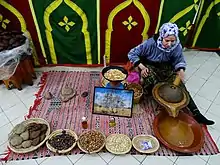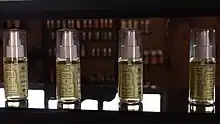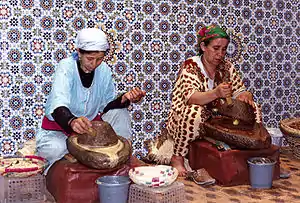Argan oil
Argan oil is a plant oil produced from the kernels of the argan tree (Argania spinosa L.) that is endemic to Morocco. In Morocco, argan oil is used to dip bread in at breakfast or to drizzle on couscous or pasta. It is also used for cosmetic purposes.[1][2]
| Argan, practices and know-how concerning the argan tree | |
|---|---|
 Argan paste making | |
| Country | Morocco |
| Reference | 955 |
| Inscription history | |
| Inscription | 2014 (14nd session) |
| List | Representative |
 | |
 Containers of argan oil | |
| Type | Plant oil |
|---|---|
| Place of origin | Morocco |
| Main ingredients | Fruit of the argan tree |
Properties
Argan oil consists mostly of fatty acids:[1]
| Fatty acid | Percentage |
|---|---|
| Oleic | 42.8% |
| Linoleic | 36.8% |
| Palmitic | 12.0% |
| Stearic | 6.0% |
| Linolenic | <0.5% |
Argan oil has a relative density at 20 °C (68 °F) ranging from 0.906 to 0.919.[2]
Argan oil contains tocopherols (vitamin E), phenols, carotenes, squalene, and fatty acids, (80% unsaturated fatty acids)[3] The main natural phenols in argan oil are caffeic acid, oleuropein, vanillic acid, tyrosol, catechol, resorcinol, (−)-epicatechin and (+)-catechin.
Depending on the extraction method, argan oil may be more resistant to oxidation than olive oil.[4]
Uses
Culinary
In Morocco, the oil is used as a foodstuff, for dipping bread, or on couscous, and for medicinal use.[5]
Amlu, a thick brown paste with a consistency similar to peanut butter, is used locally as a bread dip. It is produced by grinding roasted almond and argan oil using stones, and then mixing the argan oil and almonds in honey.[6]
Various claims about the beneficial effects on health due to the consumption of argan oil have been made. A research article published in 2010 found that argan oil contained higher levels than other oils of γ-Tocopherol, which possesses strong chemopreventive and anti-inflammatory properties.[7]
Cosmetics
Since the early 2000s argan oil has been increasingly used in cosmetics and hair care preparations.[8] As of 2020, the main cosmetics products containing argan oil are face creams, lip glosses, shampoos, moisturizers, and soaps.[5]
Extraction

The fruit of the argan tree is small, and round, oval, or conical. A thick peel covers the fleshy pulp. The pulp surrounds a hard-shelled nut that represents about 25% of the weight of the fresh fruit.
The nut contains one to three oil-rich argan kernels. Extraction yields from 30% to 50% of the oil in the kernels, depending on the extraction method.[9] It takes about 40 kilograms (88 lb) of dried argan fruit to produce only one litre of oil.[5]
Extraction is key to the production process. To extract the kernels, workers first dry argan fruit in the open air and then remove the fleshy pulp. Some producers remove the flesh mechanically without drying the fruit. Moroccans usually use the flesh as animal feed. A tradition in some areas of Morocco allows goats to climb argan trees to feed freely on the fruits. The kernels are then later retrieved from the goat droppings, considerably reducing the labour involved in extraction at the expense of some potential gustatory aversion.[10][11] In modern practice, the peels are removed by hand.[12]
The next stage involves cracking the argan nut to obtain the argan kernels. Attempts to mechanize this process have been unsuccessful, so workers still do it by hand, making it a time-consuming, labour-intensive process. Berber women often engage in this arduous task.
Workers gently roast kernels they will use to make culinary argan oil. After the argan kernels cool, workers grind and press them. The brown-coloured mash expels pure, unfiltered argan oil. Finally, they decant unfiltered argan oil into vessels. The remaining press cake is protein-rich and frequently used as cattle feed.[9]
Cosmetic argan oil is produced almost identically, though the argan kernels are not roasted to avoid an excessively nutty scent.
The decanted argan oil is left to rest about two weeks so the suspended solids settle to the bottom. The clearer argan oil is further filtered, depending on the required clarity and purity. Pure argan oil may contain some sediment.
Production

After the first sales in the US of the cosmetic product in 2003, demand soared and production increased. In 2012 the Moroccan government planned for increased production, then around 2,500 tonnes, to 4,000 tonnes by 2020.[8]
It was found that stocks of argan oil were being diluted with oils such as sunflower, as the extraction process for pure argan oil can be difficult, and is costly. In 2012, the Moroccan government started to randomly pull argan shipments and test for purity before exporting.[8]
By 2020, production had increased exponentially, especially after studies had suggested health benefits. Almost all of the oil is sourced in Morocco, and is forecast to reach 19,623 US tons (17,802 tonnes) in 2022, up from 4,836 (4387 tonnes) in 2014; in value terms, US$1.79 billion (GB£1.4 bn).[5]
The area of producing the oil is expanding: in 2020 it had started near the city of Agadir, 175 kilometres (109 mi) south of the traditional argan-producing area of Essaouira, and is due to expand north.[5]
40 kilograms (88 lb) of dried argan fruit only produces one litre of oil. Mechanically extracted oil production has started, with the industrial scale driving down prices, impacting the small co-operatives, where work is mostly done by Berber women in the traditional, labour-intensive way. Mechanically produced oil can cost as little as US$22 a litre, less than half the cost of oil made by the cooperatives. This can have a great social impact. However, the huge cosmetics company L'Oréal has pledged to source all of its argan oil from the small co-operatives that sign up to the principles of fair trade.[5]
Impacts
Environmental
The argan tree provides food, shelter and protection from desertification. The trees' deep roots help prevent desert encroachment. The canopy of argan trees also provides shade for other agricultural products, and the leaves and fruit provide feed for animals.[2]
The argan tree also helps landscape stability, helping to prevent soil erosion, providing shade for pasture grasses, and helping to replenish aquifers.[13]
Producing argan oil has helped to protect argan trees from being cut down. In addition, regeneration of the Arganeraie has also been carried out: in 2009 an operation to plant 4,300 argan plants was launched in Meskala in the province of Essaouira.[14]
The Réseau des Associations de la Réserve de Biosphère Arganeraie (Network of Associations of the Argan Biosphere Reserve, RARBA) was founded in 2002 with the aim of ensuring sustainable development in the Arganeraie.[15]
RARBA has been involved with several major projects, including the Moroccan national antidesertification programme (Programme National de Lutte contre la desertification, PAN/LCD). The project involved local populations and helped with improvements to basic infrastructure, management of natural resources, revenue-generating activities (including argan oil production), capacity reinforcement, and others.[16]
Social

The production of argan oil has always had a socioeconomic function. At present, its production supports about 2.2 million people in the main argan oil-producing region, the Arganeraie.[8]
Much of the argan oil produced today is made by a number of women's co-operatives. Co-sponsored by the Social Development Agency with the support of the European Union, the Union des Cooperatives des Femmes de l’Arganeraie is the largest union of argan oil co-operatives in Morocco. It comprises 22 co-operatives that are found in other parts of the region.[17]
As of 2020, there were around 300 small firms, mostly co-operatives, in the area about 25 kilometres (16 mi) inland from Essaouira, on the Atlantic coast. The women who harvest the seeds are mostly of the Berber ethnic group, with traditional skills dating from generations ago.[5]
Employment in the co-operatives provides women with an income, which many have used to fund education for themselves or their children. It has also provided them with a degree of autonomy in a traditionally male-dominated society and has helped many become more aware of their rights.[18]
The success of the argan co-operatives has also encouraged other producers of agricultural products to adopt the co-operative model.[19] The establishment of the co-operatives has been aided by support from within Morocco, notably the Foundation Mohamed VI pour la Recherche et la Sauvegarde de l’Arganier (Mohammed VI Foundation for Research and Protection of the Argan Tree),[20] and from international organisations, including Canada's International Development Research Centre[21] and the European Commission.[18]
However, despite many working a very long day, the women usually make less than US$221 (GB£170) a month (and even as low as US$50), which is below Morocco's recommended national minimum wage. Zoubida Charrouf, a chemistry professor at Mohammed V University of Rabat is an advocate for higher salaries, as well as the author of studies into its health benefits. She says that some companies pay drivers to bring tourists to their facilities, to sell them the oil, rather than pay their workers properly. Morocco's minister of agriculture has asked for Charrouf's help in forcing firms to join trade bodies and commit to paying staff the minimum wage.[5]
References
- Khallouki, F; Younos, C; Soulimani, R; Oster, T; Charrouf, Z; Spiegelhalder, B; Bartsch, H; Owen, RW (2003). "Consumption of argan oil (Morocco) with its unique profile of fatty acids, tocopherols, squalene, sterols and phenolic compounds should confer valuable cancer chemopreventive effects". European Journal of Cancer Prevention. 12 (1): 67–75. doi:10.1097/00008469-200302000-00011. PMID 12548113.
- Charrouf, Zoubida; Guillaume, Dominique (2008). "Argan oil: Occurrence, composition and impact on human health". European Journal of Lipid Science and Technology. 110 (7): 632. doi:10.1002/ejlt.200700220.
- Monfalouti, HE; Guillaume, D; Denhez, C; Charrouf, Z (Dec 2010). "Therapeutic potential of argan oil: a review". J Pharm Pharmacol. 62 (12): 1669–75. doi:10.1111/j.2042-7158.2010.01190.x. PMID 21054392.
- Chimi, H; Cillard, J; Cillard, P (1994). "Autoxydation de l'huile d'argan Argania spinosa L. du Maroc" [Autoxidation of argan oil Argania spinoza L. from Morocco]. Sciences des Aliments (in French). 14 (1): 117–24. ISSN 0240-8813.
- Rosengren, Izabella (6 February 2020). "The women who make argan oil want better pay". BBC News. Retrieved 7 February 2020.
- MICHELLE MINNAAR. "Amlou".
- Charrouf, Zoubida; Guillaume, Dominique (2010). "Should the Amazigh Diet (Regular and Moderate Argan-Oil Consumption) have a Beneficial Impact on Human Health?". Critical Reviews in Food Science and Nutrition. 50 (5): 473–7. doi:10.1080/10408390802544520. PMID 20373191.
- L. Siegle (February 12, 2012). "The trees of life. Should hairdressers be promoting argan oil?". The Observer.
- Charrouf, Zoubida; Guillaume, Dominique (1999). "Ethnoeconomical, ethnomedical, and phytochemical study of Argania spinosa (L.) Skeels". Journal of Ethnopharmacology. 67 (1): 7–14. doi:10.1016/S0378-8741(98)00228-1. PMID 10616955.
- Fortean Times issue 353 May 2017 pages 6 & 7 with photograph
- Greenwood, Arin (2015-09-16). "The Luxurious Poop From These Tree-Climbing Goats Produces Argan Oil". Huffington Post. HuffPost. Retrieved 7 February 2018.
- "Is your beauty oil made from goat turds? Not anymore". Public Radio International. March 30, 2010.
- Y. Moussouris & A. Pierce. "Biodiversity links to cultural identity in southwest Morocco: The situation, the problems and proposed solutions". Arid Lands Newsletter No. 48, November/December 2000.
- "Lancement d'une opération de reboisement de 13 hectares d'arganier à Essaouira". Archived from the original on 2016-08-16. Retrieved 2012-07-23.
- "Réseau des Associations de la Réserve de Biosphère Arganeraie RARBA". Archived from the original on 2016-09-14. Retrieved 2012-07-23.
- "Projet 1: Programme National de Lutte contre la desertification (PAN/LCD) en partenariat avec la coopération technique Allemande (GTZ)" (PDF). Archived from the original (PDF) on 2010-12-14. Retrieved 2012-07-23.
- "L'UCFA". Archived from the original on 2017-01-15. Retrieved 2012-07-23.
- R. Dochao. "The European Commission Supports Mediterranean Women: Three Tales about Making a Difference" (PDF).
- "Argan oil helps Moroccan women become breadwinners". BBC News.
- "La Fondation Mohamed VI pour la recherche et la sauvegarde de l'arganier tient sa première assemblée générale à Essaouira". Archived from the original on 2005-10-29.
- Z. Charrouf and S. Dubé. "Helping Moroccan Women Preserve the Argan Tree at the Gateway to the Sahara".
External links
 Media related to Argan oil at Wikimedia Commons
Media related to Argan oil at Wikimedia Commons- " Multilingual taxonomic information". University of Melbourne.
